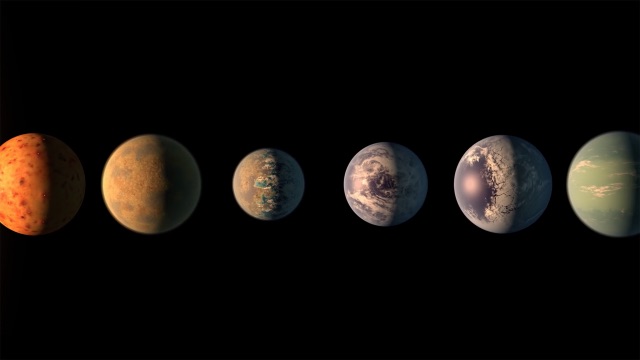New observations of the alien worlds in the TRAPPIST-1 system are providing even more support for the idea that one or more of these exoplanets could support life, and some of them may have even more water than Earth!
Each of the five lightest planets in the TRAPPIST-1 system could have 250 times more water than Earth’s oceans, according to new study of the distant worlds.
Identified as one of our best chances for finding an Earth-like planet capable of sustaining life, new information is being gleaned about the TRAPPIST-1 system thanks to the planets’ tendency to “tug” at each other.
The seven planets that orbit the TRAPPIST-1 star (imaginatively called b, c, d, e, f, g and h) are packed tightly into an area that could fit inside Mercury’s orbit of the Sun. This close distance between planets means that, as they pass each other, they make slight changes to each other’s orbits.
“In the TRAPPIST-1 system, the planets are so close together that they perturb each other. This causes a slight shift in the times of each transit,” explains Simon Grimm of the Center for Space and Habitability (CSH) at the University of Bern, and director of the research, published in the journal Astronomy and Astrophysics.
By simulating the planetary orbits based on 35 parameters astronomers had observed of the system, the researchers were able to calculate the rough masses of the planets. From this, they could deduce the potential composition of each planet – no mean feat, seeing as it took Grimm close to a year to perfect the algorithm for the computer model.
As NASA reports, the results suggest that a number of the planets could have up to 5% of their masses composed from water – 250 times more than the entirety of Earth’s oceans. What form this water takes very much depends on the heat the planet gets from its star. Those close to TRAPPIST-1 are likely to be covered in atmospheric vapour, while those far away may have vast icy expanses.
In a Goldilocks prediction, the planet TRAPPIST-1e has the best chance to be “just right”, potentially hosting liquid water — the one substance essential for life as we know it to exist . This planet also happens to be the rockiest of the bunch. Whether or not this means its habitable is a whole other question:
“Densities, while important clues to the planets’ compositions, do not say anything about habitability,” says Brice-Olivier Demory from the University of Bern, co-author of the research. “However, our study is an important step forward as we continue to explore whether these planets could support life.”
Don’t pack your galoshes just yet. TRAPPIST-1 is very far away… 39 light years away to be precise, which means it would take around 17,000 years to travel there at Voyager 1 speeds. It also may be too old to sustain life, with long exposure to the star’s radiation potentially boiling off the planets’ atmospheres. Better bring a coat as well, then.















